
|
|
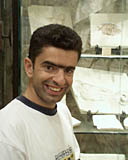 Pierre Abi Saad 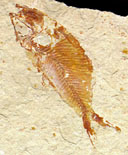 Armigatus  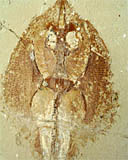 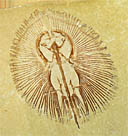  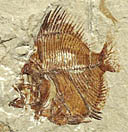 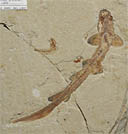 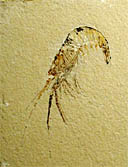 |
Memory of Time (Al Mashriq does not endorse commercial business, but from time to time such institutions are presented for the cultural information they present. Abi Saad Frères of Jbeil, Lebanon is one such business. Their activities were described in the following article from the Daily Star of May, 1998.) Photographs © Børre Ludvigsen, 1998 Catching a mermaid in Jbeil By Lara Khouzami Twenty-nine-year-old Pierre Abi Saad's job is rocks. At daybreak, he heads off to Hgula in the mountains above Jbeil to look for animals that died 100m years ago. Pierre Abi Saad is a fossil hunter. Crouched on his knees, he fidgets busily, carefully examining a stone firmly placed between his legs. Meticulously, he strikes the edges with equal blows using a hammer and chisel. Bit by bit it cracks open. Buried in the middle is a cross-section of a fish, perfectly preserved. It's an eye-popping sight. "It's 100m years old, from the upper cretaceous period," he declares. "It's from the eurypholidae family which can also be found in Europe and North Africa." Then he turns from scientist to awe-struck schoolboy: "You see, it's real," he grins. "This is our lucky day. We may spend months without finding a thing, while sometimes we find a big piece which takes days of work to retrieve in good shape." Finding the 100m-year-old fish has fuelled Abi Saad with optimism and renewed his patience. He caught the bug at an early age, getting his first hammer at five years old. "I became fascinated by fossils and over the years I began to appreciate the rich variety of fossil species in Lebanon. I was hooked." Lebanon's three main fish fossil sites, Hgula, Haqil (both in the mountains above Jbeil) and An Nammura are the only ones in the Middle East, according to Abi Saad. "They're unique," he shrugs. There are many layers of rock on the site. Some contain more fossils than others. It's like hunt-the-thimble, albeit a very old one. "It's like a puzzle," he says. "Sometimes you find part of the fish so you keep digging for the other half." Knowing where to look for fossils and which formations contain them is the key. The sites are usually marine sedimentary rocks formed in seas that don't exist any more. Historically, the earliest evidence of Lebanese fossils dates back to 1248, where it is mentioned in the journal of one Sire de Joinville, a travelling companion of Louis IX, that during the king's stay in Sidon, a stone containing "the shape of a sea fish" was presented to him. About 100m years ago the region known as Lebanon was 200m below the surface of the Tethys Sea, a geological name for the sea between Eurasian and African plates during the later palaeozoic and mesozoic eras, when the fish thrived before becoming fossilised. The Abi Saad family has harvested (they own the land) Hgula for five years building up a collection of fossils and putting some up for sale in their shop in the old souk of Jbeil. The four brothers - Albert, Joseph, George and Pierre - have recently opened up a small showroom where they display their best and rarest pieces. The shop looks more like an aquarium with a variety of 'frozen' marine life such as flying fish, squid, stingrays, skate, swordfish, sharks, shrimps and even octopi. The largest fossil is a 2.25m shark. Another is a rectangular stone embedded with small fish. Abi Saad does not sell any fossil unless he has four or five examples of the same piece. "We're collectors," he says seriously. Be that as it may, fossil prices can fetch as much as $1,000, although Abi Saad is quick to point out that a small piece can be picked up for as little as $5. Some are priceless. Fossils are cleaned up before they are displayed. Excess rock is delicately removed using small tools. Broken specimens can be repaired. "Fossil collection requires care and attention. When you know their value, you treat them differently," says Abi Saad. To satisfy his passion, the collector tries to "read any book related to fossils. I even studied archaeology at the Lebanese University. But not all fossil identification and research can be done here because we don't have adequate resources," he says with a disgruntled tone. "Our fossils are either fish, crustaceans (shellfish) or cephalopods (squids, octopi, etc). We've collected more than 250 species of fish, of which 150 so far have been identified, in addition to 29 species of shark." Pictures of the unidentified fossils are sent to the Natural History Museum in London or Museum de L' Histoire Naturel in Paris for study and classification. They are also sent for identification to the Université Claude Bernard in Lyon, where Abi Saad currently is taking a correspondence course in palaeontology - the study of past geological periods as known from fossil remains. Very few Lebanese show any interest in the remains of ancient life, he admitted. Most of his clients are foreigners. "I sometimes meet ten-year-old foreign children who know as much about fossils as I do." To increase people's awareness, he takes groups of schoolchildren to visit the site, letting them dig around. "They love it." Pierre Abi Saad evidently loves it too. "It's like fishing. You wait and wait and when you catch that big fish you're happy. But fossils are more magical because instead of catching an ordinary fish, you catch a mermaid." |
|
Memory of Time |
|
 981026/bl |
|